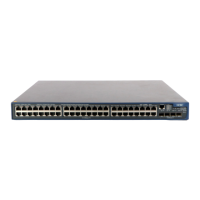4-18
Field Description
Priority Priority of DR for interface election
Designated Router DR on the network in which the interface resides
Backup Designated Router BDR on the network in which the interface resides
OSPF timers, defined as follows:
Hello Interval of hello packet
Dead Interval of dead neighbors
Poll Interval of poll
Timers
Retransmit Interval of retransmitting LSA
Transmit Delay Delay time of transmitting LSA
display ospf lsdb
Syntax
display ospf process-id area-id lsdb [ brief | [ [ asbr | network | nssa | router | summary ]
[ ip-address ] ] [ originate-router ip-address | self-originate ] ]
display ospf [ process-id ] lsdb [ brief | [ [ asbr | ase | network | nssa | router | summary ]
[ ip-address ] ] [ originate-router ip-address | self-originate ] ]
View
Any view
Parameters
process-id: OSPF Process ID. If you do not specify a process ID, this command applies to all current
OSPF processes.
area-id: OSPF area ID, which can be a decimal integer (ranging from 0 to 4294967295) or in the form of
an IP address.
brief: Displays brief database information.
asbr: Displays the database information about Type-4 LSAs (summary-Asbr-LSAs).
ase: Displays the database information about the Type-5 LSAs (AS-external-LSAs). This argument is
unavailable if you have provided a value for area-id.
network: Displays the database information about the Type-2 LSAs (network-LSAs).
nssa: Displays the database information about the Type-7 LSAs (NSSA-external-LSAs).
router: Displays the database information about the Type-1 LSAs (router-LSAs).
summary: Displays the database information about the Type-3 LSAs (summary-net-LSAs).
ip-address: Link state identifier (in the form of an IP address).
originate-router ip-address: Specifies the IP address of the router advertising the LSAs.
self-originate: Displays the database information about the LSAs generated by the local router
(self-originate LSAs).

